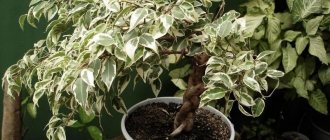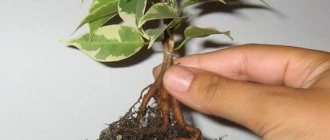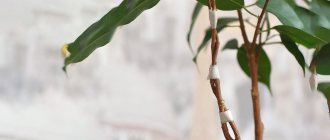The popularity of Benjamin ficuses is high, they are loved by interior designers and owners; plants not only decorate a home or office, but also purify the air and improve energy. This is an excellent gift that people of any social status and financial situation will enjoy. To get a lush bush or intertwine trunks, you will have to place several seedlings in one pot, but this is not such a problem. Even a novice gardener can easily propagate ficus benjamina.
Propagation of ficus benjamina by cuttings
To obtain young ficus trees, it is not at all necessary to take only the apical parts of the shoots. The plant develops when a stem cutting with buds dormant in the axils of the leaves takes root.
If there is not enough planting material for propagating Ficus Benjamin, even a single bud will give life to the shoot.
Cuttings are cut from an adult plant so that:
- the base of the future seedling was semi-lignified, that is, still flexible, but no longer green, like newly formed shoots;
- there were from 4 to 6 unfolded leaves on the stem.
On cut stems of all varieties of ficus, milky juice is released. Before rooting, it is removed under running water or using a soft cloth. The lower leaves that interfere with rooting are cut off:
- Immature, green cuttings are almost impossible to root. From prolonged exposure to water or substrate, they rot and die.
- If the gardener has only fragments of adult, lignified branches at his disposal, then there is a chance to get roots.
How to root Ficus Benjamin in the latter case? The base of the cutting is carefully cut along the stem with a very sharp knife. There may be several such cuts. To prevent parts of the cutting from touching, place a match or toothpick between them. This original technique allows you to stimulate root formation on ordinary cuttings, and is also used by bonsai lovers to obtain miniature plants of the most bizarre shapes.
When propagating ficus benjamina, cuttings are rooted in several ways:
- in water;
- in perlite;
- in a light, loose substrate, for example, consisting of peat, crushed charcoal and sand.
At an air temperature of at least 20 °C and high air humidity, roots will form in 2–4 weeks. To speed up the process, use an indoor greenhouse or cover the container with cuttings with a bulk bag.
The roots formed during the propagation of Ficus Benjamin are quite powerful. When they grow a few centimeters. It’s time to transfer the seedling to its permanent place of “residence” in the ground.
For a young ficus, which willingly and quickly grows a root system, take a ready-made aerated, moisture-permeable substrate. Sometimes you make your own soil mixture. Examples include soil based on leaf and turf soil, peat and perlite. In such soil, the ficus will receive proper nutrition and securely gain a foothold.
In the first weeks of acclimatization, the seedlings are covered with a bag, which is removed when the plant produces its first leaves.
At home, propagation of Ficus Benjamin can be done using cuttings with just one leaf and a small section of the stem.
The main thing is that there is a healthy, viable kidney in the sinus. In this case, the shoot along the internodes is cut into separate fragments, which are immediately dried with a napkin and planted in the substrate. The soil should reach the base of the leaf petiole, and the leaf plate itself should be carefully rolled up and secured in the form of a tube. This will prevent the seedling from evaporating too much moisture, precious for the tiny plant.
Plant diseases
Some symptoms will indicate that the Benjamin flower is sick. By carefully monitoring the plant, you can prevent trouble.
Leaves wither
This problem occurs when there is excessive or insufficient watering, due to “stress” after transplantation, or in an excessively dry room climate.
Brown leaf tips
Brown spots on the tips appear when the temperature in the house is too high, the air is dry, or due to overfeeding with fertilizers.
If the ficus is located near the battery, move it to another place and regularly spray it with warm water.
Thin shoots
Small leaves on new thin shoots indicate a lack of lighting or nutrients. It is for this reason that the flower does not grow to its full potential. Take care of the optimal amount of light by using a phytolamp in winter, and do not forget to fertilize the plant as required by the rules.
Yellow leaves
The leaves begin to turn yellow due to excessive watering. Pay attention to whether the soil has dried out after the last irrigation. If it is still wet, do not water the flower, maintain moderation.
The leaves are falling
If the loss of leaves is not related to the age of the flower, then the reason lies in the low temperature in the house, excess minerals in the soil, or lack of lighting. Protect the flower from drafts. A sudden change in indoor climate can leave a ficus without leaves.
Tip : spray the flower with the Epin biostimulator. This solution helps protect the plant from the negative effects of temperature changes and other aggressive factors.
Doesn't increase in height
In general, stunting of ficus growth is caused by a lack of moisture or nutrients in the soil. Spray the flower regularly and fertilize it until new shoots and leaves form.
Lumps on leaves
The appearance of yellow spots and bulges on the leaves indicates waterlogging of the soil. Under no circumstances should water stagnate in the pan. Do not overdo watering in winter when the flower is dormant.
Ficus benjamina is an almost ideal indoor plant due to its beautiful appearance and undemandingness to special conditions - that is why even novice gardeners love it and successfully grow it. With some effort and following simple care rules, you can also get an elegant decorative tree that will always delight you with its bright green crown and also create home comfort.
Rooting methods
When propagating ficus benjamina at home
cuttings are rooted in water or prepared soil. If the air temperature is maintained at 20-22 °C and the required air humidity is maintained, the shoot will take root within a month. Of course, they make sure that the young shoots are not attacked by insect pests, and that the roots do not rot. With proper care and compliance with sanitary standards, rooting using both methods will be successful. To stimulate cell division and root formation, the bottom of the cutting is treated with Kornevin. A few drops of this or an analogue drug can simply be dissolved in liquid.
In water
Ficus benjamina rooting in water
Reproduction of ficus benjamina
by rooting the shoots in water, they are carried out in a container with a removable bottom. The transplant process will be greatly facilitated. For successful formation of the root system, water is poured so that it does not affect the lower leaves of the shoot, otherwise their leaf plate will begin to rot. To prevent trunk rot, dissolve coal powder in water. The conditions for growth are the same as for an adult plant. The fluid is changed periodically. When the ficus cuttings give roots, the seedlings are planted in the ground for a permanent place of “residence”.
In the ground
A longer method in time. Sections of processed and dried twigs are sprinkled with charcoal powder. Then they are lowered onto one bud into prepared and disinfected soil. As soon as the seedling is planted, the soil should be watered with warm water and lightly compacted. For successful rooting, young ficus benjamina
placed in an improvised greenhouse.
It is created from cling film or a bag in which a hole is made. The polyethylene should cover the pot with soil, leaving the shoot outside. As with the previous rooting method, the pot is placed in a warm, bright place, avoiding direct drafts and maintaining moderate soil moisture. Make sure that it is not overfilled. Periodically, the cellophane is removed to ventilate the substrate. This will prevent rotting of the roots. When young growth forms foliage, propagation of ficus benjamina
went well.
Useful tips
- Half the success for growing a beautiful and healthy Ficus Benjamin is the soil. They love light, fertile, slightly acidic soil. It is best to collect soil in a park, in a forest under linden or pine trees. The collected soil will make up one part, the second part will be humus, and the third will be sand. You should not use rotted manure as part of the soil, since midges develop in it.
- The plant will be comfortable in winter at a temperature of 20–22 degrees.
- In the spring-summer period, ficus feels better on the veranda or glazed balcony.
- In the first years of life, Ficus Benjamin does not need feeding, but if it develops slowly, you can feed it with special fertilizer for ficuses. Wood ash and infusion of weeds are also used for fertilizing. The infusion is diluted with water one to ten.
- For better development, the plant is replanted every two to three years. But if the ficus grows well, this rule is deviated from.
About the design:
- If desired, the plant can be formed into a tree or bush.
- To form a ficus in the shape of a tree, all the lower branches are cut off. When the stems grow, they cut them into a ball shape or give them a pyramidal shape.
- Ficus benjamina produces very spectacular bonsai that can be grown in two years.
- To add special splendor and increase decorativeness, plant two or three plants in a container. You can braid the shoots, securing it at the top with a rope. Just don’t pull the stems tightly; they need to develop freely, even intertwined. When such a “pigtail” gains strength, the plant will be extremely impressive with a beautiful decorative crown.
To prevent diseases of Ficus Benjamin, you can use dog shampoo. This is an excellent tool for killing pests on plants. A soap and water solution is made and the leaves and trunk of the ficus are washed.
Ficus Benjamin is not only beautiful, easy to care for and effective, but also has a beneficial effect on the energy in the house, removes negativity and improves a positive aura.
Seed propagation
If there is nowhere to get cuttings for propagating ficus, you can buy the seeds of this evergreen flower in the store. Planting must be done in moist, nutritious, specially prepared soil to a depth of 0.5 cm. To prepare the substrate, take one part of turf soil, one part of perlite, one part of leaf humus and bone meal at the rate of 10 g per 10 liters of the mixture.
When propagating seeds, the plant requires constant care:
- the temperature where the box with seedlings is located should always be within 22-26°C;
- throughout the entire germination period, regularly and moderately moisten the soil (about 3 months).
As soon as the first pair of leaves emerge from the ground, the seeds have sprouted and the ficus can be planted.
The seed propagation method is not very popular among gardeners, since propagation takes a lot of time and there is not always a guarantee that, despite constant care, at least one seed will germinate.
Other nuances of work
When breeding, you need to consider a few more important points. The advice of experienced gardeners is usually as follows:
- It is better to buy and plant ficus trees in warm weather. The flower does not tolerate temperature fluctuations. Even if the shoot stays outside for just a few minutes in winter, this can sometimes lead to death.
- For better development of cuttings, you need to position the container correctly. Do not place in drafts. Sprouts are afraid of direct sunlight. It is advisable to rearrange it as little as possible so that lighting and other conditions do not change. An adult plant has the same requirements.
- The room temperature is about +20−25 °C, in winter - about -15 °C.
- Before transplanting, you need to water the developing plant regularly. The frequency and volume of liquid depends on the specific variety. The water is warm, settled.
- Tools used for pruning are processed. They must be clean, sterile and sharp.
- Rooting time may vary. It depends on the conditions, variety, and strength of the cuttings. If after 3-4 weeks there are no leaves, there is no need to panic and throw away the plants. Perhaps it is too early, for example, because the seedling was weakened.
- From each branch you can take as many cuttings as there are leaves. The plant doesn’t need much: just one leaf and an intact eye.
- Phytohormones can be used. Rooting will happen faster with them.
- If a tree-like ficus is propagating, you can take the top of the trunk or stem with at least one node.
- The stalk is sometimes cut at the bottom. This is necessary for better rooting. If the variety has a soft stem, one cut is enough; for a hard one, make a cross.
- It is advisable to replant the plant when there are already four leaves.
Monstera: flower propagation at home
How to propagate ficus benjamina at home
Currently propagating Ficus Benjamin
carried out through the following four methods:
- sowing seeds;
- cloning;
- seedling cuttings;
- selection of layering.
Propagation by seeds at home
hampered by low performance.
Cloning is usually used for industrial purposes. In this case, a new flower is grown from a leaf. Ficus Benjamin
tolerates propagation by cuttings and layering best.
Apical cuttings
Reproduction by apical cuttings photo
Before propagating Ficus Benjamin
cuttings, you should make sure that the main plant is not infected and not too old. Semi-lignified cuttings 9-15 cm long are cut from the top of the bush with a sharpened knife at an angle of 45° closer to the node. Remove excess foliage, leaving 3-4 leaves. The released milky juice must be washed off. By drying out, it prevents the full development of the root system. You can put the sprout in warm water, changing it until the milk stops secreting. After this, the cuttings are dried and placed in a vessel with water at room temperature.
Attention! Do not cut cuttings with scissors or blunt objects. Plant tissue can be crushed, which will slow down the rooting of branches.
To avoid rotting of the cuttings, dissolve an activated carbon tablet in water and make sure that the leaves do not touch its surface. Container with cuttings at home
Place in a bright place, avoiding direct sunlight.
As evaporation occurs, water is added. After half a month, Ficus Benjamin
will form growths at the end of the cuttings, from which roots will form. When their length reaches 3-5 cm, the seedlings can be planted in the substrate.
Stem cuttings
propagation by stem fragments photo
How to propagate Ficus Benjamin
method of isolating cuttings from stems? The woody shoot can be cut into segments. Each of them should have 2-4 sheets. The upper cut is made above the bud in the axil of the leaf, and the lower cut is cut obliquely, taking the part between the nodes. After washing, stopping the secretion of milky juice and drying in air, the cutting is buried in the ground up to the petiole of the leaf, and the leaf itself is rolled into a tube and tied with tape or an elastic band.
Attention! With this type of cutting, roots form more slowly. It is expected that some fragments will not take root at all.
At home
containers with planted cuttings are covered with polyethylene to maintain the desired level of humidity.
Roots and first leaves can form in 1-1.5 months. To speed up rooting, several cuts are made on the lower cut of the branches. This way Benjamin’s ficus
will become more active in growing a new root system.
Air layering
Reproduction by air layering photo
Ficus benjamina propagation
It withstands air layering as well as rhododendron. In the middle of the trunk or woody branch, remove the foliage and carefully cut off the bark in the shape of a ring. The exposed tissue is treated with Kornevin. Then it is covered with damp moss or a substrate based on it and carefully wrapped in film, securing the structure with tape or rope.
The first roots at the cut site will appear in about two months. After this, the cuttings are released, and the new seedling is cut below the newly formed rhizome. The cut areas are easily sprinkled with charcoal powder. The young cuttings can be planted in the ground.
Is it possible to plant shoots without roots?
Ficus cuttings can be placed in the ground without prior germination. It is enough just to remove the milky juice by keeping the cut in water for 2-3 hours. Several blanks are placed in a loose substrate and a greenhouse is built over them.
For proper rooting it is necessary to ensure:
- moderate humidity,
- temperature not lower than 25°C,
- bright but not scorching lighting.
New shoots on the cuttings will appear in 35-45 days. During this period, the greenhouse begins to be opened and then removed completely.
For your information! Transplanting cuttings rooted in the ground is not necessary. The first replacement of soil and pot is carried out a year later, next spring.
Features of ficus propagation by layering
How to propagate ficus benjamina at home by air layering - a more complex method than cuttings, but it is much more interesting. Part of the bark is cut off from a trunk or well-lignified shoot in a ring-shaped manner. This must be done very carefully so as not to damage the middle.
The “wound” is treated with Kornevin (a good stimulator of root growth) and wrapped around with moistened moss. Instead of moss, a sphagnum-based soil composition is often used. Everything is fixed with polyethylene and secured with tape.
Next, observe the process: roots will soon appear on the cut. They should be freed, and the shoot itself should be cut below them and planted in a permanent pot with previously prepared nutrient soil. It is important not to forget about the tree that served as a donor by treating the wound with crushed coal or garden pitch.
Now the new little Ficus Benjamin tree is growing on its own, and if the branch is planted in good soil, it will definitely take root.
You can tell your friends and acquaintances about how to grow a ficus from a twig. This interesting method is most often used by plant growers who grow small bonsai trees - this way they get a large number of aerial roots that hang from the ficus, giving them originality and decorativeness.
Popular questions and answers
We talked about the problems in growing Ficus Benjamin with agronomist-breeder Svetlana Mikhailova.
Where is the homeland of Ficus Benjamin?
This ficus has a fairly wide habitat. It grows in tropical areas of Asia - India, China, Indonesia, the Philippines and northern Australia.
How to choose Ficus Benjamin?
The main thing is that the plant is healthy - without spots on the leaves and bare shoots, which may indicate leaf fall. If possible, remove the plant from the pot and inspect the roots - they should be healthy and free of rot. And remember that varieties with unusual leaf colors are more whimsical; they often do not forgive mistakes in care.
Why do ficus benjamina leaves fall?
The main reasons are lack of light, lack of moisture or, on the contrary, excessive watering, drafts, diseases and pests. To cope with the problem, you need to adjust the care or treat the plant.
Why do the leaves of Ficus Benjamin turn yellow?
The reasons are the same as those that cause leaves to fall off - improper watering, a bad place where the ficus grows (it may not have enough light), drafts, diseases and pests.
To prevent this from happening, it is important to find a suitable place for the ficus, follow the care recommendations and treat it on time. Sources
- Visyashcheva L.V., Sokolova T.A. Industrial floriculture. Textbook for technical schools // M.: Agropromizdat, 1991 – 368 p.
- Tulintsev V.G. Floriculture with the basics of selection and seed production // Stroyizdat, Leningrad branch, 1977 - 208 p.
- State catalog of pesticides and agrochemicals approved for use on the territory of the Russian Federation as of July 6, 2022 // Ministry of Agriculture of the Russian Federation, https://mcx.gov.ru/ministry/departments/departament-rastenievodstva-mekhanizatsii-khimizatsii -i-zashchity-rasteniy/industry-information/info-gosudarstvennaya-usluga-po-gosudarstvennoy-registratsii-pestitsidov-i-agrokhimikatov/
We propagate ficus in the ground
There is another way to propagate ficus using cuttings at home - planting cut branches directly into the ground. To do this, you need to select a special mixture of soil that young ficus plants love. If you want to make the mixture yourself, for this we take in equal parts:
- peat soil;
- sand;
- leaf humus.
You can also find packages with the finished substance in stores; they are also suitable for this procedure.
For such rooting, we prepare cuttings in the same way as in the instructions above. After that:
- take the dried cut and sprinkle it with crushed coal;
- we plant the sprout in the ground on one bud;
- cover the plant with a three-liter jar, thus creating a mini greenhouse for it, a plastic bag will also do;
- we water the soil moderately, until it grows it should not be dry, but at the same time you should not make a “swamp”;
- put the pot in a warm place, for example next to a radiator, but no direct sunlight;
- When the branch takes root, you will see new leaves, after which we gradually remove our greenhouse. We start with 15-20 minutes a day so that the tree gets used to the new conditions.
Photo
The photo shows the rooting process of the ficus "Benjamina":
Now that you have learned about all the nuances of breeding ficus “Benjamina” and want to do it, read our other articles about this plant:
- Features of care at home.
- Diseases and pests, as well as ways to combat them.
- Rules for replanting a houseplant.
- Useful and dangerous properties of the plant for the home.
Planting cuttings
Planting cuttings of ficus benjamina photo
If ficus benjamina is propagated
transferred in water with rooting, then it is planted in a pot. Planting is carried out in accordance with the following steps:
- choose a pot or flowerpot with holes at the bottom and fill the bottom with a layer of drainage made of expanded clay, small pebbles, fragments of brick or tile;
- fill the pot with a layer of prepared soil, leaving 2-3 cm to the top;
- moisten the ground, make a hole and place the cutting in it, having previously cut the roots to the same length;
- The roots are covered with soil, without compacting them too much, as this can damage the delicate root system of the plant. The soil itself will be brought down to the desired level by watering.
Young ficus benjamina
requires a ventilated, moisture-permeable and nutritious substrate. If it is not possible to buy a ready-made earthen mixture for ficus in the store, then it is created independently from soil, turf, peat, sapropel, sand and perlite collected under leafy trees.
What kind of soil does it like?
Ficus Benjamin is quite demanding on the composition of the substrate. Particular care must be taken in selecting soil for germinating cuttings and planting young plants.
Basic soil requirements:
- looseness,
- air and water permeability,
- nutritional value,
- neutral or minimal acidity.
The ideal composition for planting is special store-bought soil with the addition of coarse river sand. If it is not possible to purchase a ready-made substrate, it is mixed independently from the following components:
- turf,
- peat,
- sand,
- leaf humus.
For young plants, all substrate components are mixed in equal proportions. To reduce acidity, a small amount of wood ash is added to the mixture.
Leaf method
Large-leaved ficus trees can also be propagated using the leaf method. True, it is closer in technique to cuttings and does not involve propagating a plant from individual large leaves. To resort to propagation using this method, take a shoot with a leaf, since it is in the axil of the leaf that the bud will develop, from which a young shoot will grow. If you pick a large leaf directly, it may even give roots, but a new plant will not develop from it and there is no point in rooting it.
Unlike the previous method, the cut is made precisely along the internode. After cutting the cutting, place it in water to root. As in the previous case, you can plant directly into the ground, deepening to the leaf petiole. It is advisable to roll the sheet itself into a tube and secure it. Some people recommend using a thin rubber band or electrical tape for this purpose, but the gentlest choice is a soft wool thread. The care conditions are the same as for cuttings.
Procedure technology
To get a new healthy, viable plant in a short time, you need to correctly take shoots from the ficus. You can use several at once to ensure rooting is successful, but usually one is enough. Before taking cuttings, you should prepare the necessary tools, available materials, containers, water or substrate, and only then carry out the procedure.
How to take a ficus shoot:
- Choose a young, developed shoot with at least one healthy eye.
- Cut with a sharp knife so that the bud remains on top; above it, you can remove the excess part of the branch at a right angle. It is advisable to cut the bottom of the rubber-bearing ficus at an angle; half of the internode without an eye should remain on the cutting.
- Place the shoot in warm water for several hours, dry it, and treat the damaged stem with crushed activated carbon. If this is not done, the released juice will clog the passages, making it more difficult for the roots to break through.
- Cultivate in water or substrate.











